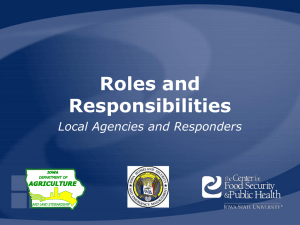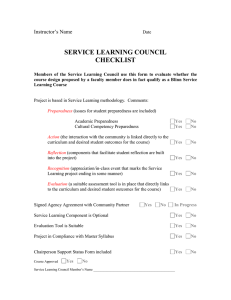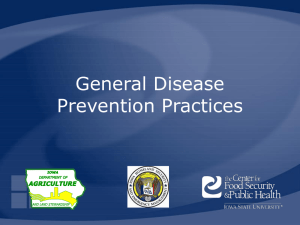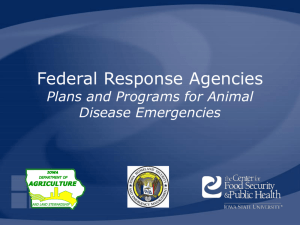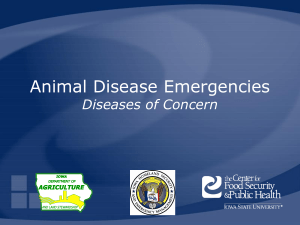Business Continuity
advertisement
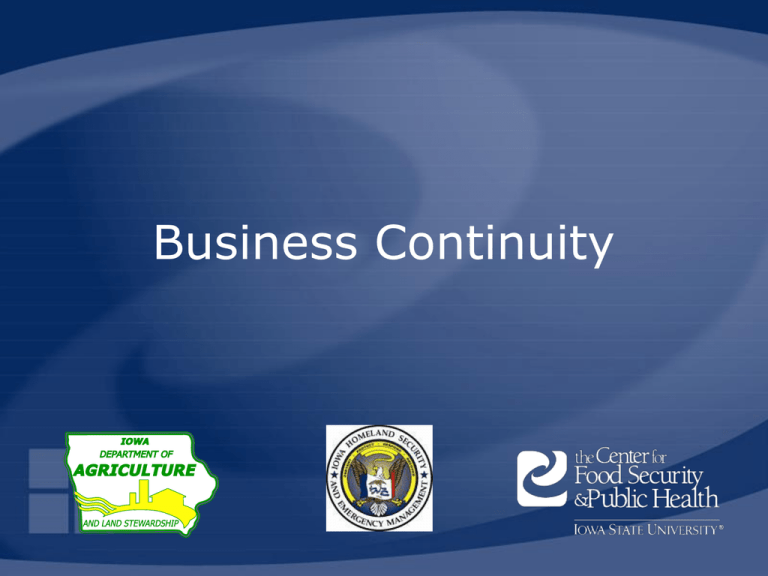
Business Continuity Learning Objectives • • • Recognize the impact an animal disease outbreaks can have on business List the basic process for developing a business continuity plan Identify risks to your business following an animal disease outbreak HSEMD, IDALS, CFSPH Animal Disease Emergency Local Response Preparedness, 2008 Impact of Animal Disease • • How will you or you business be impacted by an animal disease outbreak in your state, your county, within 5 miles? Are you prepared to handle the impact an animal disease outbreak could have both financially and mentally? HSEMD, IDALS, CFSPH Animal Disease Emergency Local Response Preparedness, 2008 Impact of Animal Disease • • • • Would stop movement and road blocks impact your business? Are animal owners your customers or suppliers? Does the agriculture market impact your business? Even if you don’t have animals, are you located in close proximity that you would be in a control zone? HSEMD, IDALS, CFSPH Animal Disease Emergency Local Response Preparedness, 2008 Prior to Disaster • • • • • “It will never happen to me” “It won’t be that bad” “I have insurance” “The government will take care of me” Preparation and planning are essential for businesses to survive a disaster HSEMD, IDALS, CFSPH Animal Disease Emergency Local Response Preparedness, 2008 YOYO Philosophy HSEMD, IDALS, CFSPH Animal Disease Emergency Local Response Preparedness, 2008 Federal State HSEMD, IDALS, CFSPH Increasing severity or scale of incident Local Local support may include: Road barricades – Quarantine enforcement – Checkpoint personnel – Decon stations and personnel – Transportation – Additional communications capacity – GPS equipment – Base of operations – Training/orientation facility – Staging area for equipment – Food, lodging – Supplies, resources as needed for task management – Animal Disease Emergency Local Response Preparedness, 2008 Planning for YOYO Phase • • • • Protect your family, employees Protect pets and livestock Protect your property, business Critical community resources for: Those with special needs – Most severely impacted – • Be part of the solution – Not part of the problem HSEMD, IDALS, CFSPH Animal Disease Emergency Local Response Preparedness, 2008 Basic Planning Elements Hazards Consequences Vulnerabilities Risk Analysis Planning Resources Emergency Operations Plan Mitigation Strategies HSEMD, IDALS, CFSPH Animal Disease Emergency Local Response Preparedness, 2008 Business Continuity • Establish a planning team – Analyze capabilities and hazards • – Identify critical products, services, operations • – – Internal plans, local government, codes and regulations Facilities, equipment, supply needs, water, electricity, essential personnel, internal resources, insurance policies Conduct a vulnerability analysis Develop the plan HSEMD, IDALS, CFSPH Animal Disease Emergency Local Response Preparedness, 2008 Business Continuity Plan • • • • • • Direction and control Communications Life safety Property protection Community involvement Administration and logistics HSEMD, IDALS, CFSPH Animal Disease Emergency Local Response Preparedness, 2008 Business Continuity Plan • Recovery and restoration Planning considerations – Continuity of management – Insurance – Employee support – Resuming operations – HSEMD, IDALS, CFSPH Animal Disease Emergency Local Response Preparedness, 2008 Planning Pays Off • • No or poor plan can result in losses In the event of a major disaster 58% of businesses die – 43% never reopen – 29% that reopen close in 2 years – • For every $1 spent on planning, $7 saved from disaster loss (FEMA) HSEMD, IDALS, CFSPH Animal Disease Emergency Local Response Preparedness, 2008 Resources • Emergency Management Guide for Business & Industry – • • www.fema.gov/business/guide/index.shtm Small Business Administration – Disaster preparedness and recovery information for businesses – www.sba.gov/services/disasterassistance/index.html Association of Contingency Planners – 1-800-445-4ACP – www.ACP-International.com HSEMD, IDALS, CFSPH Animal Disease Emergency Local Response Preparedness, 2008 Acknowledgments Development of this presentation was funded by a grant from the Iowa Homeland Security and Emergency Management and the Iowa Department of Agriculture and Land Stewardship to the Center for Food Security and Public Health at Iowa State University. Contributing Authors: Glenda Dvorak, DVM, MPH, DACVPM; Danelle BickettWeddle, DVM, MPH, DACVPM; Gayle Brown, DVM, PhD HSEMD, IDALS, CFSPH Animal Disease Emergency Local Response Preparedness, 2008
